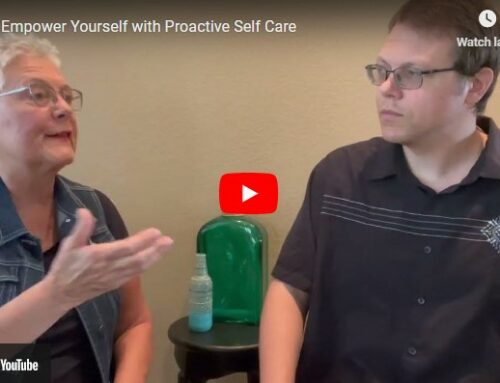Food Fact and Fiction (Part II)
by Reisha Zang
Sorting food fact and fiction can be difficult. What foods are really good for you? What should you avoid? Dr. Tina Marcantel is a naturopathic
doctor practicing in Gold Canyon, Arizona. Other East Valley cities she serves are Gilbert, Mesa, Chandler, Tempe, Scottsdale, Queen Creek, Apache Junction, and the greater Phoenix area. Reisha Zang is a contributing writer to Lifestyle magazine.
(This article first appeared in Northeast Mesa Lifestyle magazine, January 2007 edition. Excerpts from the article are published here by permission of the
author.)

Trick or treat?
Sometimes we just want to eat something because it tastes good. And it’s fun to eat something forbidden like chocolate. It turns out that chocolate might not be such a big no-no after all. We are not talking about just any chocolate, though. It needs to be a good quality dark chocolate. “Cocoa contains antioxidant flavanols, which fight free radicals that are responsible for disease,” said
Marcantel. “Antioxidants can lower cholesterol, act as an anti-inflammatory and enhance blood flow.” She recommends a dark chocolate containing 70 to 80 percent cocoa, with less than 4 grams of sugar per serving. “Once your taste buds get used to it, you don’t miss the sweet chocolate,” she said. But you still need to be aware of the calorie content.
There are so many things to take into account when making food choices. “What do I feel like eating?” “Will it make me fat?” “Can it improve my overall well being or cure my cold?” The key to improving your diet is to improve your choices. Exchange bad habits for good ones, such as replacing white bread with whole grain bread. Keep in mind that if you are consistently eating a bad selection of food, adding an apple or fish once in a while will not undo the damage.
It is easy to get caught up in the latest fads and advice reported in the news, but you should not eliminate whole groups of foods, like fats or carbohydrates, completely from your diet. And don’t use new research to justify overindulging
in wine or dark chocolate. Moderation is the key, along with eating a variety of foods.To skip or not to skip?
Though skipping meals could help you lose weight faster, it can also cause excessive snacking. While it might seem like a good way to lose weight, people who skip breakfast tend to be heavier than people who regularly eat in the morning. It is important to eat a healthy breakfast, but you should monitor the amount of juice you are drinking in the morning. “You only need about 6 ounces of 100 percent vitamin C juice,” said Pendergraft. “The rest becomes empty calories,
essentially sugar, because you have already gotten the vitamin C you need.” She suggests eating an orange instead. “It is more satisfying and makes you feel fuller.” Eating breakfast helps avoid tiredness, hunger, and the craving for sugary foods before lunch.Curb the carbs?
When lunchtime does arrive, are french fries an OK choice? Popular belief is that no carbs and low fat are the answer to losing weight. However, according to Johnson, science and studies have shown that it is extra calories that make you
fat. “It doesn’t matter where the calories come from—carbs, proteins, or fat,” she said. “If you eat more calories than your body needs, you are going to store it as fat.” So, potatoes cooked in oil are probably not a wise food choice because of the high calorie content. But, said Johnson, “Potatoes are a good food—they are a source of vitamin C, fiber, and potassium.” They do not need to be avoided, because our bodies need carbohydrates.
“You can’t live without carbs,” said Pendegraft. It is the type of carbohydrates that you need to be careful about. “Candy bars, sodas, and potato chips offer no nutrition,” she said. “They are just empty calories.” She encourages people to choose whole wheat or bran foods and brown rice over white rice. These food choices contain more nutrition and provide a benefit because they have more fiber.
Fear fatty foods?
Ourbodies also need fats, but not the kind found in fried foods or bacon. Oliveoil, flax seed oil, and canola oil are essential fatty acids (EFAs) which ourbodies need. “Good fats are so very important,” said Marcantel. “They help keep the walls of the cells in our bodies nice and flexible,” she said. “This allows nutrients to get in and waste products to get out.” EFAs are also found in walnuts, pumpkin seeds, avocados, and cold-water fish like salmon.
Refuse red meat?
So, is red meat really bad for you? Is chicken always a better choice than beef? Not necessarily. Removing the skin and fat lowers the fat content in chicken, but according to the National Institutes of Health (NIH), red meat, pork, chicken, and fish all contain some cholesterol and saturated fat, but they also have healthy nutrients like protein, iron, and zinc.
Marcantel feels that red meat in moderation is an important part of a healthy diet. This is because red meat contains hemoglobin, which is where you will find “true iron.” She further explained, “You can get iron as a supplement, but true
iron helps build up our own iron, hemoglobin, and hematocrit.” The NIH suggest choosing lower fat meats like beef round or flank steak, tenderloin or extra lean ground beef and limiting your portions to 3 ounces.
The best way to make a positive change in your diet is to meet with your physician or nutritionist. They will evaluate different factors in your diet and life to determine which foods will provide the most benefit for you. Together, you can
develop a plan specifically to meet your individual needs. Learning about new food trends from someone who knows can have a big payoff. It can add variety to your diet, spice to your life, and may even include “bad” foods you thought you had to avoid.





